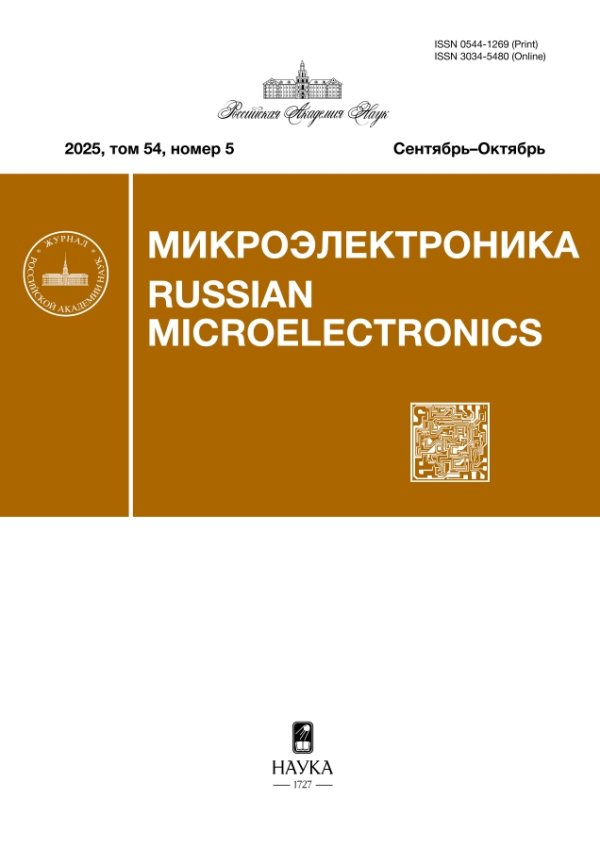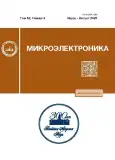Влияние мощности магнетронного распыления на осаждение пленок ITO при комнатной температуре
- Авторы: Саенко А.В.1, Вакулов З.Е.1, Климин В.С.1, Билык Г.Е.1, Малюков С.П.1
-
Учреждения:
- Институт нанотехнологий электроники и приборостроения, Южный федеральный университет
- Выпуск: Том 52, № 4 (2023)
- Страницы: 329-335
- Раздел: ТЕХНОЛОГИИ
- URL: https://journals.rcsi.science/0544-1269/article/view/138580
- DOI: https://doi.org/10.31857/S0544126923700394
- EDN: https://elibrary.ru/IAWXYW
- ID: 138580
Цитировать
Полный текст
Аннотация
Методом магнетронного распыления в режиме средних частот (MF) получены пленки ITO на стеклянных подложках при комнатной температуре в бескислородной среде. Проведено исследование влияния мощности магнетронного распыления на электрофизические свойства и морфологию поверхности пленок ITO. Показано, что скорость осаждения пленки ITO линейно зависит от мощности магнетронного распыления в режиме MF. Получено, что пленки ITO имеют преимущественно нанокристаллическую структуру при мощности магнетронного распыления больше 100 Вт. Увеличение мощности распыления приводит к возрастанию шероховатости поверхности от 13.5 до 24.6 нм и размера зерен от 11.7 до 27.5 нм в пленке ITO. Минимальное удельное сопротивление пленок ITO составило 6.82 × 10–4 Ом см при концентрации и подвижности носителей заряда 2.48 × 1020 см–3 и 36.8 см2/В с, которое соответствует оптимальной мощности магнетронного распыления 200 Вт. Полученные результаты соответствуют высокому уровню значений поверхностного сопротивления для пленок ITO (34.1 Ом/□), которые могут использоваться при формировании прозрачных проводящих электродов в солнечных элементах и мемристорах, как на стеклянной, так и на гибкой подложках.
Ключевые слова
Об авторах
А. В. Саенко
Институт нанотехнологий электроники и приборостроения,Южный федеральный университет
Email: avsaenko@sfedu.ru
Россия, 347928, Таганрог, ул. Шевченко, 2
З. Е. Вакулов
Институт нанотехнологий электроники и приборостроения,Южный федеральный университет
Email: avsaenko@sfedu.ru
Россия, 347928, Таганрог, ул. Шевченко, 2
В. С. Климин
Институт нанотехнологий электроники и приборостроения,Южный федеральный университет
Email: avsaenko@sfedu.ru
Россия, 347928, Таганрог, ул. Шевченко, 2
Г. Е. Билык
Институт нанотехнологий электроники и приборостроения,Южный федеральный университет
Email: avsaenko@sfedu.ru
Россия, 347928, Таганрог, ул. Шевченко, 2
С. П. Малюков
Институт нанотехнологий электроники и приборостроения,Южный федеральный университет
Автор, ответственный за переписку.
Email: avsaenko@sfedu.ru
Россия, 347928, Таганрог, ул. Шевченко, 2
Список литературы
- Amador Perez-Tomas. Functional Oxides for Photoneuromorphic Engineering: Toward a Solar Brain // Adv. Mater. Interfaces. 2019. V. 6. P. 1900471.
- Jago Txintxurreta, Eva G-Berasategui, Rocio Ortiz, Oihane Hernandez, Lucia Mendizábal, Javier Barriga. Indium Tin Oxide Thin Film Deposition by Magnetron Sputtering at Room Temperature for the Manufacturing of Efficient Transparent Heaters // Coatings. 2021. V. 11. P. 92.
- Marikkannan M., Subramanian M., Mayandi J., Tanemura M., Vishnukanthan V., Pearce J.M. Effect of ambient combinations of argon, oxygen, and hydrogen on the properties of DC magnetron sputtered indium tin oxide films // AIP Advances. 2015. V. 5. P. 017128.
- Abdelaziz Tchenka, Abdelali Agdad, Mohamed Cheikh Samba Vall, Salma Kaotar Hnawi, Abdelfattah Narjis, Lahcen Nkhaili, Elalami Ibnouelghazi, Elmaati Ech-Chamikh. Effect of RF Sputtering Power and Deposition Time on Optical and Electrical Properties of Indium Tin Oxide Thin Film // Advances in Materials Science and Engineering. 2021. P. 1–14.
- Goncharov E.V., Sayenko A.V., Malyukov S.P., Palii A.V. Formation of ITO Thin Films by MF Magnetron Sputtering for Solar Cells Application // Proceedings of ITN-T 2021 – 7th IEEE International Conference on Information Technology and Nanotechnology, 2021.
- Amalraj Peter Amalathas, Maan M. Alkaisi. Effects of film thickness and sputtering power on properties of ITO thin films deposited by RF magnetron sputtering without oxygen // J. Mater Sci.: Mater Electron, 2016. V. 27. P. 11064–11071.
- Chih-hao Yang, Shih-chin Lee, Tien-chai Lin, Suz-cheng Chen. Electrical and optical properties of indium tin oxide films prepared on plastic substrates by radio frequency magnetron sputtering // Thin Solid Films. 2008. V. 516. P. 1984–1991.
- Jae-Ho Kim, Hae-Jun Seok, Hyeong-Jin Seo, Tae-Yeon Seong, Jin Hyuck Heo, Sang-Hyuk Lim, Kyung-Jun Ahnd, Han-Ki Kim. Flexible ITO films with atomically flat surfaces for high performance flexible perovskite solar cells // Nanoscale. 2018. V. 10. P. 20587–20598.
- Hyung-Jin Choi, Soon-Gil Yoon, Ju-Ho Lee, Jeong-Yong Lee. Crystallized Indium-Tin Oxide (ITO) Thin Films Grown at Low Temperature onto Flexible Polymer Substrates // ECS J. Solid State Science and Technology. 2012. V. 1(5). P. 106–109.
- Kelly P.J., Henderson P.S., Arnell R.D., Roche G.A., Carter D. Reactive pulsed magnetron sputtering process for alumina films // J. Vacuum Science and Technology A. 2000. V. 18. № 6. P. 2890–2896.
- Bradley J.W., Karkari S.K., Vetushka A. A study of the transient plasma potential in a pulsed bipolar dc magnetron discharge // Plasma Sources Sci. Technol. 2004. V. 13. P. 189–198.
- Miaoju Chuang. ITO Films Prepared by Long-throw Magnetron Sputtering without Oxygen Partial Pressure // J. Mater. Sci. Technol. 2010. V. 26(7). P. 577–583.
- Guillen C., Herrero J. Polycrystalline growth and recrystallization processes in sputtered ITO thin films // Thin Solid Films. 2006. V. 510. P. 260–264.
- Kudryashov D., Gudovskikh A., Zelentsov K. Low temperature growth of ITO transparent conductive oxide layers in oxygen-free environment by RF magnetron sputtering // J. Physics: Conference Series. 2013. V. 461. P. 012021.
- Kosariana A., Shakiba M., Farshidi E. Role of Sputtering Power on the Microstructural and Electro-Optical Properties of ITO Thin Films Deposited Using DC Sputtering Technique // IEEJ Transactions on Electrical and Electronic Engineering. 2018. V. 13. P. 27–31.
Дополнительные файлы
















